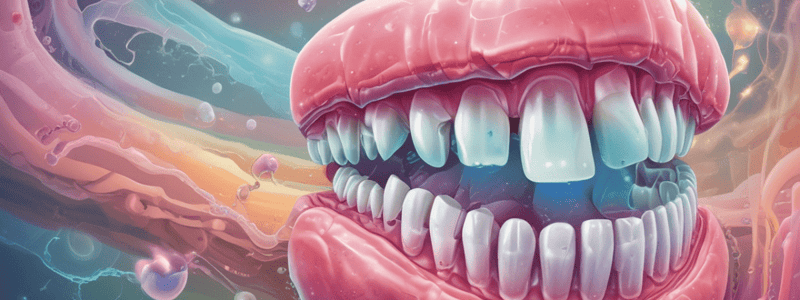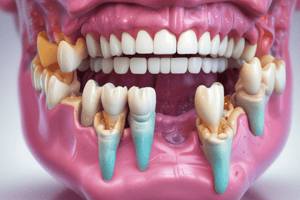Podcast
Questions and Answers
What is a potential risk of dental surgeries?
What is a potential risk of dental surgeries?
- Caries
- Gastrointestinal tract infection
- Bloodstream infection that might cause endocarditis (correct)
- Dental plaque formation
Which of the following bacteria is an early colonizer in dental plaque?
Which of the following bacteria is an early colonizer in dental plaque?
- Porphyromonas
- Fusobacterium
- Bacteroides
- Streptococcus sanguis (correct)
What is the main function of high-molecular-weight extracellular glucan polymers in dental plaque?
What is the main function of high-molecular-weight extracellular glucan polymers in dental plaque?
- To act as a cement binding the plaque biofilm together (correct)
- To break down carbohydrates
- To produce acid
- To synthesize proteins
Which of the following is a method for controlling caries?
Which of the following is a method for controlling caries?
What percentage of normal flora in the large intestine are anaerobic?
What percentage of normal flora in the large intestine are anaerobic?
What happens to normal flora in the upper part of the small intestine?
What happens to normal flora in the upper part of the small intestine?
What is the term used to describe the mixture of microorganisms that are regularly found at any anatomical site of the human body?
What is the term used to describe the mixture of microorganisms that are regularly found at any anatomical site of the human body?
Why are viruses and parasites not usually considered members of the normal flora?
Why are viruses and parasites not usually considered members of the normal flora?
What is the process by which microorganisms are present on skin or mucosa but do not penetrate into tissues?
What is the process by which microorganisms are present on skin or mucosa but do not penetrate into tissues?
Why do the internal organs of the human body usually remain sterile?
Why do the internal organs of the human body usually remain sterile?
What is the primary source of normal flora for a newborn?
What is the primary source of normal flora for a newborn?
What is the characteristic of resident flora?
What is the characteristic of resident flora?
Which of the following organisms is not a member of the normal flora?
Which of the following organisms is not a member of the normal flora?
What is the primary function of Lactobacillus spp. in the vagina?
What is the primary function of Lactobacillus spp. in the vagina?
Which of the following is not a site where normal flora organisms are typically found?
Which of the following is not a site where normal flora organisms are typically found?
What is the term for an individual who has pathogenic organisms present in significant numbers and can be a source of infection for others?
What is the term for an individual who has pathogenic organisms present in significant numbers and can be a source of infection for others?
What is the primary function of the normal microbiota in the body?
What is the primary function of the normal microbiota in the body?
What is the term for the microorganisms that are permanent residents of the body and are found in everyone?
What is the term for the microorganisms that are permanent residents of the body and are found in everyone?
What is the primary mechanism by which potential pathogens gain a competitive advantage?
What is the primary mechanism by which potential pathogens gain a competitive advantage?
What is the primary source of colonization of normal flora in a human infant?
What is the primary source of colonization of normal flora in a human infant?
What is the primary anatomic location of Corynebacteria in the normal flora?
What is the primary anatomic location of Corynebacteria in the normal flora?
What is the primary reason why normal flora on the skin can cause bloodstream infections?
What is the primary reason why normal flora on the skin can cause bloodstream infections?
What is the primary mechanism by which Streptococci of the viridens group can cause infective endocarditis?
What is the primary mechanism by which Streptococci of the viridens group can cause infective endocarditis?
What is the primary role of normal flora in human health?
What is the primary role of normal flora in human health?
What is the primary anatomic location of Pseudomonas in the normal flora?
What is the primary anatomic location of Pseudomonas in the normal flora?
Flashcards
Dental Plaque
Dental Plaque
Complex biofilm on teeth surfaces.
S. sanguis, S. mutans, S. mitis
S. sanguis, S. mutans, S. mitis
Gram-positive bacteria; early plaque colonizers.
Porphyromonas, Prevotella, Fusobacterium
Porphyromonas, Prevotella, Fusobacterium
Gram-negative anaerobes; late plaque colonizers.
Extracellular Glucan Polymers
Extracellular Glucan Polymers
Signup and view all the flashcards
Bacterial species in plaque
Bacterial species in plaque
Signup and view all the flashcards
S. mutans
S. mutans
Signup and view all the flashcards
Physical Plaque Removal
Physical Plaque Removal
Signup and view all the flashcards
Limit Sucrose
Limit Sucrose
Signup and view all the flashcards
Stomach Bacteria
Stomach Bacteria
Signup and view all the flashcards
Large Intestine Bacteria
Large Intestine Bacteria
Signup and view all the flashcards
Bacteroides
Bacteroides
Signup and view all the flashcards
Normal Microbiota
Normal Microbiota
Signup and view all the flashcards
Flora Acquisition Begins
Flora Acquisition Begins
Signup and view all the flashcards
Resident Flora
Resident Flora
Signup and view all the flashcards
Urinary Tract
Urinary Tract
Signup and view all the flashcards
Vaginal Flora
Vaginal Flora
Signup and view all the flashcards
Colonization
Colonization
Signup and view all the flashcards
Infection
Infection
Signup and view all the flashcards
Symbiosis
Symbiosis
Signup and view all the flashcards
Mutualism
Mutualism
Signup and view all the flashcards
Commensalism
Commensalism
Signup and view all the flashcards
Parasitism
Parasitism
Signup and view all the flashcards
Microecosystem
Microecosystem
Signup and view all the flashcards
Microecology
Microecology
Signup and view all the flashcards
Staphylococcus epidermidis
Staphylococcus epidermidis
Signup and view all the flashcards
Study Notes
Dental Plaque and Caries
- Dental plaque is a complex biofilm that forms on teeth
- Initial colonizing organisms in dental plaque are mainly gram-positive bacteria, such as Streptococcus sanguis, S. mutans, S. mitis, S. salivarius, S. oralis, and S. gordonii
- Late colonizers in dental plaque include gram-negative anaerobes, such as Porphyromonas, Prevotella, Fusobacterium, and Veillonella species, as well as anaerobic spirochetes like Treponema denticola
- High-molecular-weight extracellular glucan polymers are synthesized in dental plaque, acting as a cement to bind the biofilm together
- There are approximately 300-400 bacterial species present in mature dental plaque
- S. mutans is considered the dominant organism in the initiation of caries
Control of Caries
- Physical removal of plaque is an effective method of controlling caries
- Limiting sucrose intake and maintaining good nutrition with adequate protein intake can help prevent caries
- Frequent cleansing of the teeth and mouth is also important for preventing caries
Gastrointestinal Tract
- The stomach has few bacteria due to gastric enzymes and acidic pH
- The small intestine has few normal flora in its upper part, but more in its lower parts
- The large intestine has the most bacteria of any part of the body, with 99% being anaerobic Bacteroides species
- Many fungi, protozoa, and viruses can live in the large intestine
- Some normal flora in the large intestine are opportunistic, meaning they can cause infection if they move to other areas of the body
Human Normal Microbiota
- The human normal microbiota is the mixture of microorganisms that regularly inhabit the human body
- The normal microbiota consists of a few eukaryotic fungi, many bacteria, and some viruses and parasites
- The normal microbiota varies in number and kind from one site to another
- Internal organs are usually sterile, but the normal microbiota can be present in asymptomatic individuals
Normal Flora
- A fetus is sterile when born, but starts acquiring normal flora from its mother, air, food, and environment
- Normal flora differs from one human to another depending on age, diet, and geographic habitat
- The skin and mucous membranes always harbor a variety of microorganisms, which can be classified into two groups: resident flora and transient flora
- Resident flora is the microorganisms regularly found in a given area at a given age, and can reestablish itself if disturbed
Urogenital Tract
- The urinary tract is usually sterile, except for the lower urethra and external opening, which has bacteria similar to those found on the skin
- The female urethra can become colonized with fecal flora, which can predispose to urinary tract infections
- The genital organs are usually sterile, except for the vagina, which has a normal flora of Lactobacillus spp. that keeps the pH acidic to protect against opportunistic infections
Colonization vs Infection
- Colonization is the presence of microorganisms on skin or mucosa, without penetration into tissues
- Infection is the invasion of a host organism by microorganisms, followed by proliferation and host reaction
Relationship Between Individuals
- Symbiosis is the permanent association between two different organisms
- Types of symbiosis include mutualism, commensalism, and parasitism
Microecosystem and Microecology
- The human body has various microecosystems, such as the skin, mouth, nasopharynx, ear, eye, and gastrointestinal tract, each with its own unique microecology
- Each microecosystem has its own specific microorganisms that inhabit it
Medically Important Members of Normal Flora
- Skin: Staphylococcus epidermidis, Staphylococcus aureus, Propionibacterium acnes
- Mouth: E. coli
- Nasopharynx: Pseudomonas
- Ear: Streptococcus
- Eye: Neisseria
- Gastrointestinal tract: Corynebacteria
- Urinary tract: various bacteria
- Reproductive tract: various bacteria
Studying That Suits You
Use AI to generate personalized quizzes and flashcards to suit your learning preferences.




